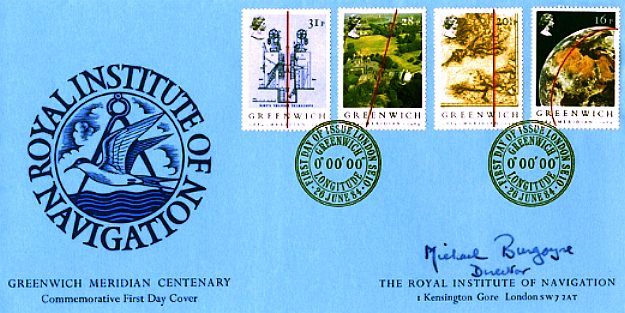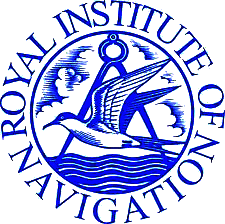|

The Royal Institute of Navigation is a British institution devoted to the art and science of navigation established in 1947.
Its aims are to bring navigators together, to develop navigational techniques and to increase public awareness of
navigation. It is based in Kensington, London. It was granted its
Royal Charter in 2007.
Since
the 1970s, RIN working parties have published reports on navigation and safety
issues, covering topics from the importance of traffic separation and collision prevention in the maritime environment to fuel reserves in
aircraft. As the Institute's focus
broadened it organises conferences to discuss these issues at national and
international level.
Navigation is a roving animal with the development of Loran, then in 1978 the launch of the first GPS
satellite. Such developments challenged the very idea of a Royal Institute of
Navigation. This is because position-finding is now a relatively automated
function.
In 1984, a 'Way Ahead Group' appointed by the RIN Council recommended several crucial additions to its profile, including the creation of Special Interest Groups and the launch of a
newsletter. The newsletter became Navigation News.
These developments allied to a determination to embrace global satellite navigation systems and information technology as important elements in modern navigation, helped the RIN
become a 21st century organisation.
Between 1984-1994, the Institute ran a series of larger
European conferences and added more and more Special Interest Groups to its portfolio, including the Land Navigation and Location Group and the Navigation on Foot Group, to reflect the growth in popularity of navigation hobbies such as geocaching,
hill walking and orienteering.
The creation of a range of competitions helped the Institute attract younger members and, more recently,
they have added significant numbers of university students to their membership.

RIN
AIMS & OBJECTIVES
The RIN has three stated main aims:
1. To unite all those with a professional or personal interest in any aspect of navigation in one unique body.
2. To further the development of navigation in every sphere.
3. To increase public awareness of the art and science of navigation.
In order to achieve its aims, the RIN:
Operates a range of events via Special Interest Groups and regional
Branches.
Runs targeted events and international conferences, highlighting the hot issues, the best research and leading activity in the navigation
industry and works closely with international bodies including the International Association of Institutes of Navigation (IAIN), the European Group of Institutes of Navigation (EUGIN), the International Maritime Organization (IMO) and International Civil Aviation Organisation (ICAO) to determine policy and best practice in the world of navigation.
Houses the Cundall Library of Navigation - the UK's leading navigation-specific library of books and resources - which is open to the public, and from which,
unfortunately, only members can borrow.
RIN FUTURE
The process of evolution continues today. In 2002 the RIN made its first appearance on the
internet, and its website has been consistently popular ever since as a source of news for everyone with an interest in navigation.
In 2004, the Council began investigating ways to provide members with legal protection. Three years later, to mark its 60th anniversary in 2007, the Institute changed its status once again, as it had to mark its 25th. It gained a Royal Charter, becoming an 'incorporated body' just after the stroke of midnight on January 1 2007. In the wake of the change, the Institute
developed a new logo and website for the 21st Century.
RIN COUNCIL MEMBERS 2012 - 2013
The Institute's affairs are overseen by an elected President, Officers and Council. Council is made up of Trustees and ex officio representatives from the services, Department for Transport and Civil Aviation Authority.
The Council is based at the RIN headquarters, within the Royal Geographical Society building in
London. The Council has three main Committees - Technical, Membership & Fellowship, and Finance. The Technical Committee includes members from most or all of the Institute's Special Interest Groups.
President - C M D Beatty
Vice Presidents - Capt JB Taylor OBE RN & Prof A P Norris
Treasurer - D Cockburn
Chairman of the Technical Committee - Dr S Basker
Chairman of the Membership & Fellowship Committee - Wg Cdr J W Lindsay RAF
Other members of the Council:
I C Benham
Sqn Ldr J Cairns RAF
Lt Cdr F A Egeland-Jensen RN
Dr R Filjar
Lt Cdr S E Gaskin RN
Dr N D Hughes OBE
R A McKinlay
Prof T Moore
Ms M M G M von Wendland
Capt R J Wild
Director - Capt P Chapman-Andrews LVO MBE RN

CORPORATE
MEMBERS
SMALL
BUSINESS MEMBERS
AFFILIATE
MEMBERS

CONTACT
THE RIN
The
Royal Institute of Navigation
1 Kensington Gore
London, SW7 2AT
Tel: +44 (0)20 7591 3134
Fax: +44 (0)20 7591 3131
Email: admin@rin.org.uk
Peter
Chapman-Andrews - Director
Tel:
+44 (0)20 7591 3134 director@rin.org.uk
Sally-Anne
Cooke - Conference and Events Manager
Tel:
+44 (0) 20 7591 3135 conference@rin.org.uk
Colin
Hatton - Membership Secretary/Administrator/General
Enquiries
Tel: +44 (0)20 7591 3134 membership@rin.org.uk
Tony
Fyler - Magazine
Editor/Press Enquiries/Librarian
Tel: +44 (0)20 7591 3133 editor@rin.org.uk
Nicholas
Smith
- Bookkeeper
Tel:
+44 (0)20 7591 3132 accounts@rin.org.uk
Contact
the Editor with your news story: admin@rin.org.uk
Autonomous
Ships Seminar
VESSEL
EFFICIENCY COMPETITION - Piloting UK marine and maritime innovation
= 50% of eligible costs
Together with the MOD’s Defence, Science and Technology Laboratory and
Scottish Enterprise,
TSB are investing up to £8m in collaborative R&D and fast-track projects to deliver viable solutions for more efficient marine vessels.
It is not really a competition, which suggests a prize. It is a
sweetener for existing business to invest in high risk projects that
would otherwise not get the go ahead.
They are looking for UK businesses – from inside and outside the industry – to develop solutions covering many aspects of efficiency in existing and
future ships,
boats, submarines, and their associated equipment and systems.
TSB are seeking innovative proposals that address the issues of improving current vessel performance and efficiency, but at the same time attract projects for
future vessel
design, coatings and propulsion systems.
The competition is also aiming to build collaboration across the maritime and marine industry, and develop
UK-based supply chains and SMEs to underpin a national Strategy for Growth.
Proposals must be collaborative and business-led. TSB would like to see micro and small businesses involved. We expect to invest between £500k and £3m per project, although projects outside this range will be considered.
This is a fast track and two-stage CR&D competition that opens on 14
January 2013. The deadline for applicants to register for both types of project
was noon on the 20 February 2013 and the deadline for expressions of interest
was at noon on 27 February 2013.
A briefing event for potential applicants was held in London on 22 January 2013 and consortia-building events, to help applicants to find partners.
HEADINGS
The competition aims
to accelerate
innovation and technologies to enable more efficient vessels by attracting
UK supply chains to deliver solutions that could include (but are not limited to) the
following themes, amongst others:
*
weight optimisation
* smart materials
* positioning and communications
* autonomous sensing, avionics and advanced navigation
* smart green propulsion and alternative low
carbon/emission systems
* vessel design and engineering.
KEY
DATES
Competition opens 14 January 2013
Briefing event 22 January 2013
Registration deadline 20 February 2013 noon
Expressions of interest (EOI) deadline 27 February 2013 noon
Stage 2 opens for invited applicants 18 March 2013
Deadline for invited applications 1 May 2013 noon
LINKS
http://www.rin.org.uk/

The
latest Solarnavigator is designed to be capable of an autonomous
world navigation set for an attempt in 2015 if all goes according
to schedule. This scientific expedition will improve safety
at sea by demonstrating robotic navigation at a practical level.
|



